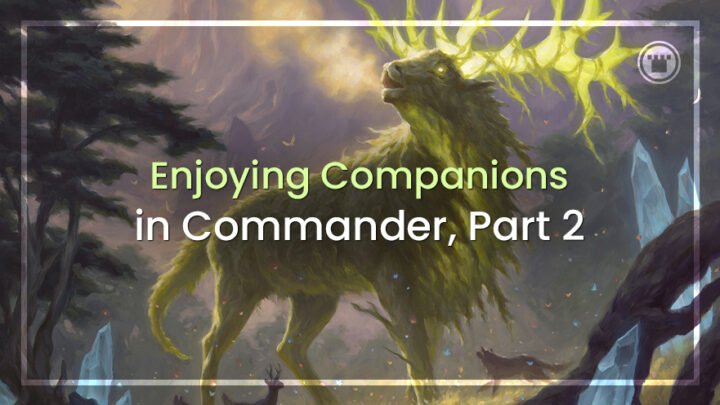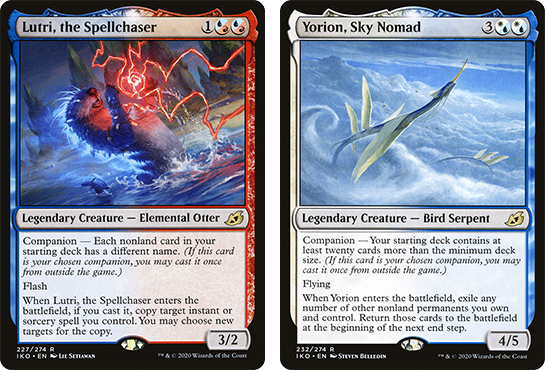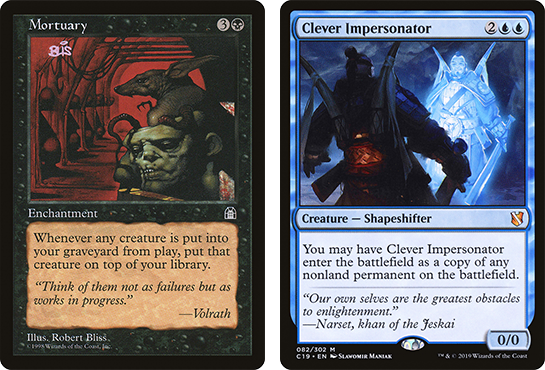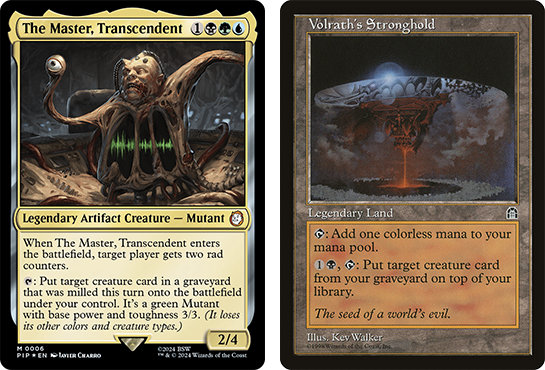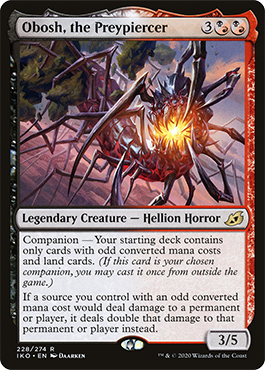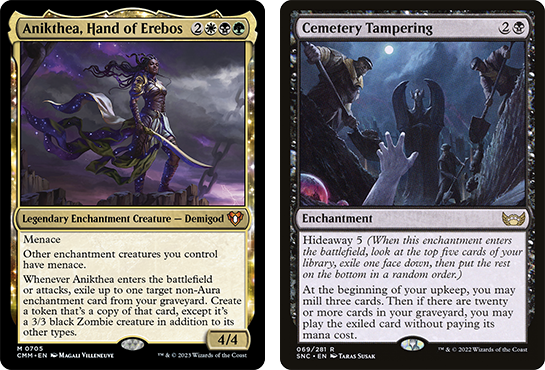Though much maligned in Constructed, the companion mechanic from Ikoria offers Commander players a unique opportunity to both customize and empower their deckbuilding. In return for meeting the right deckbuilding restrictions, we can add a powerful extra card to our command zone – ranging from an extra ramp piece to potential win condition.
We explored the Commander potential of the first three companions for an earlier article, back in January. Lutri is on the banlist, and Yorion’s deckbuilding restriction is impossible to meet due to the strict deck-size rules of Commander. That leaves five remaining Ikoria companions we can potentially bond with for additional power and consistency – so let’s look at how to solve their deckbuilding puzzles.
Gyruda, Doom of Depths
Gyruda stands out from most of the Commander-legal companion choices, and not just because of its metal-as-hell creature type. Other than Keruga, the Macrosage, all our other companions provide passive value by sitting in play.
But Gyruda’s power is front-loaded into a one-off trigger, making it much easier to multiply that value through cloning, flickering, or recursion! Better still, the actual effect is one which absolutely rewards repeated use – each trigger adds more value to your board, but also digs deeper into your deck to find more fuel or potential game-ending payoffs. A well-tuned Gyruda deck can potentially ride their first chain of triggers all the way to a win; or set up a guaranteed loop like Mortuary plus a sacrifice outlet.
Such all-in builds are definitely what Gyruda is known for in other formats, and it’s not difficult to recreate in Commander with all the extra clone and flicker effects we have available. Although if that’s our goal, perhaps we should just make the Doom of Depths our actual commander? For the sake of this article, I’d rather keep it in the companion slot. But keep in mind that these trigger loops are always going to be important when playing with Gyruda, even if they aren’t our main gameplan.
If we’re looking at commanders which appreciate Gyruda for something other than instant wins, it’s mostly mill decks that are already heavy on creatures and recursion. All three versions of Lazav fit well with our demon kraken, especially the two which can copy opposing creature cards. The Master, Transcendent gives you extra reanimation from Gyruda’s mill (including odd-cost targets from opposing decks), and can use its own ability to cheaply play or replay the companion with setup from Scroll Rack or Volrath’s Stronghold.
Other good three-color options include the evergreen Muldrotha, the Gravetide, and Saruman of Many Colors – who gets a bit of extra value from having guaranteed access to a high-cost spell in the companion zone.
Obosh, the Preypiercer
We move on from the all-evens companion to the all-odds option in Obosh. The Preypiercer is a relatively versatile companion to build around, asking only that you keep it in play while dealing as much damage as possible. Focusing on damage may not always be the efficient choice in Commander, but multiplicative scaling certainly is – and I love how Obosh can give an immediate nitro boost to traditional red burn and creature aggro to help those classic strategies threaten powerful Commander tables.
However, there are also more specialized builds we can aim for which make Obosh even more impactful. Red “damage redirection” decks are among my all-time favorite niche strategies, and get by far the most value out of a damage-doubling ability like Obosh.
A Lightning Bolt cast with Obosh in play deals 6 damage to your opponent. But if you redirect that Lightning Bolt damage from Wrathful Raptors to Brash Taunter and THEN to your opponent, Obosh doubles the damage between every step, to a total of 24 damage! Now imagine how much carnage would occur if you cast an Arcbond or Blasphemous Act in such a situation…
It’s not a totally new idea to combine redirection and damage doubling in this way, but having such a key effect in the command zone is a very sweet bonus. Obosh’s restriction does rule out some of the cards you would normally play, but there’s still enough for the deck to consistently do its thing. Boros Reckoner, Stuffy Doll, Repercussion (careful with that one), Spiteful Sliver, Wrathful Red Dragon, Pariah, Pariah’s Shield, as well as Dictate of the Twin Gods and other backup doubling effects.
When choosing a commander for this deck, it may be worth just choosing something strong with white or green in its color identity, since there are some important synergy cards you might want from those colors. Otherwise, Tor Wauki the Younger or Rankle and Torbran are top picks for bringing their own damage-scaling abilities to stack on top of Obosh.
You can also run Vial Smasher the Fierce or Judith, the Scourge Diva as a reliable way to deal non-combat damage; the latter is especially nasty if you tend to blow up your own board with red-based damage sweepers.
Umori, the Collector
Umori is certainly one of the most restrictive companions when it comes to deckbuilding, but they do say restrictions build creativity!
Since we also need to field a commander which matches the chosen type, we only have 4 valid builds for this companion: all creatures, all artifacts, all enchanments, and all planeswalkers. I would not be very excited about that last one either – while enough planeswalkers exist to fill out your deck, the lack of ramp, instant interaction, and just cheap spells in general would make it torture to play.
An all-creatures build is perhaps the most common, and has the easiest time covering all the traditional needs of a Commander deck within one card type. You have mana dorks for ramp; Acidic Slime and Grist the Hunger Tide for removal; Fauna Shaman and Fiend Artisan as tutors; Harvester of Souls and Soul of the Harvest for draw; Sylvan Safekeeper for protection. It’s a fun, stable deck which happens to run an extra cost-discounter in the Command Zone, and maybe that’s all you need out of our friendly Ooze.
Umori is perhaps at its most impactful and dynamic in the all-artifacts build. Here, almost every spell is guaranteed to benefit from a generic mana discount – and many can be made completely free, which is by far the most valuable breakpoint for cost reduction effects. Combining card draw (or topdeck access like Mystic Forge and Bolas’s Citadel) and sacrifice value engines like Krark-Clan Ironworks and Scrap Trawler creates a situation where Umori becomes a game-winning combo piece, rather than just an also-there value card.
The all-enchantment build has traditionally been the least powerful of the three, in part because it has the most limited choice of commanders. But with the printing of Anikthea, Hand of Erebos, I think this version of Umori can finally show off its unique potential! Green-black has plenty of enchantments which provide self-mill, as well as generating value from the cards being milled.
Stacking these up gives you a healthy income of free stuff every upkeep. More importantly, it will help you build a rich arsenal of targets for Anikthea’s unique enchantment-reanimating effect. Umori itself helps to cover two minor but definite weaknesses of the build; a low creature count, and a lack of ramp relative to average mana cost.
Companion Conclusions
I don’t think there’s as much to say about the final two companions, mostly because they are so generic. While they can certainly be effective in a lot of situations, neither the deckbuilding restrictions nor the abilities of Jegantha or Kaheera lead to unique Commander gameplay.
Jegantha can at least provide an easy way of cheating out spells with Jodah, Archmage Eternal and Fist of the Suns. If you can give it vigilance, it lets a Najeela, the Blade Blossom deck go infinite using only the Command Zone – or it allows Sisay, Weatherlight Captain to immediately tutor for Najeela. Beyond that, it’s usually just a decent extra card to have lying around, if you think it’s worth auditing your mana costs to make sure it’s an eligible companion. Kaheera is even more straightforward: it can provide a free lord to dinosaur or cat typal decks, or a free blocker in creature-less control decks.
But I personally don’t mind having a few of the companions be a little less prescriptive. If you want to really twist your brain in knots building a functional Commander deck under tight restrictions, play Umori or Keruga. If you want your companion to be a high-impact gamechanger or even a primary combo piece, look into Gyruda, Obosh, or Zirda. We may only ever have 8 Commander-legal companions to choose from, but their versatile and varied designs means we’ll still be figuring out new ways to build them for years to come!

Tom’s fate was sealed in 7th grade when his friend lent him a pile of commons to play Magic. He quickly picked up Boros and Orzhov decks in Ravnica block and has remained a staunch white magician ever since. A fan of all Constructed formats, he enjoys studying the history of the tournament meta. He specializes in midrange decks, especially Death & Taxes and Martyr Proc. One day, he swears he will win an MCQ with Evershrike. Ask him how at @AWanderingBard, or watch him stream Magic at twitch.tv/TheWanderingBard.

